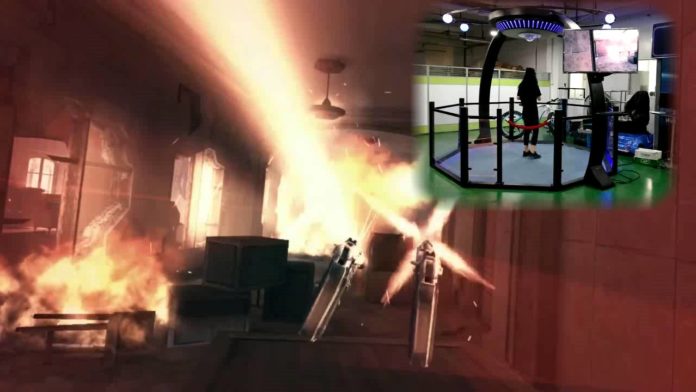Recently, we wrote about Merrell’s Trailscape experience, a self-contained VR obstacle course meant to show off the most high-tech shoe in hiking. There are some challenges to bringing this kind of experience to the home, so location-based attractions like Trailscape are starting to take off in a big way.
The key to these installations? Storytelling. VR allows you to do more with a workout then check off data points, which is what the usual gym workout is all about. Serious workout sessions are like class. They involve note taking and number crunching. VR allows you to get those same reps in an environment that challenges your whole body, motivated by an end goal that masks the reality of your workout.
Here are some of the benefits to VR’s location-based model.
Dedicated Space
An arcade or dedicated space (often a trailer or a warehouse) can provide a bigger workspace to craft a more interactive experience. One of the hangups for home VR is that the user’s space presents an unknown. A lot of shooting games anchor the player because the developer can’t accurately estimate how much space you have, so they can’t craft a walking experience based around that. A dedicated space removes this variable, so the development can incorporate programming that takes advantage of set dimensions.

This is important if you want to institute fancier tricks for locomotion, like redirected walking. With a dedicated space, the virtual world can be crafted around how the developer wants the user to move. It’s not hard to imagine a high-intensity workout that involves escaping a dangerous building while it’s crumbling apart in an earthquake or a fire, running from checkpoint to checkpoint to help rescue others. In a dedicated space, you can sprint short distances or alternate between running and jogging.
Another advantage to dedicated spaces is better movement tracking, and a lack of cables. One of the hallmarks behind Trailscape was cable management, so users could move freely throughout the space without feeling anchored in place and breaking immersion. With more sensors mapping out the space, and a lack of cords hindering movement, jumping and crouching are possible too.
Immersive Workouts

With a dedicated space comes lots of fixtures and physical objects the user can interact with. Lots of sensors and good motion tracking mean it’s possible to pick up a physical object and interact with it. Something as simple as a foam pad could serve as an obstacle to climb. Rock walls can become massive precipices with a fall thousands of feet to the bottom.
The intensity of that work out is both physical and mental. Your heart rate will increase because of the situation, and storytelling helps keep you immersed and your body in the moment reacting to what’s around you. At a gym, you might reach the halfway point of the rock wall and give up to try again later. In VR, giving up means falling off a mountain.
VR can also help you feel a sense of accomplishment, while pushing you to improve over time. The program can make the halfway point of the rockwall feel like you’ve gotten to the top. The workout would then scale each time you returned thank to sophisticated stat tracking.
Community Focused
One of the strengths the average gym has over working out on your own is the motivating factor of community. Whether it’s a personal trainer or taking a class with a group of other people, struggling through your plateaus is a lot easier when you have others alongside you. Even if you get serious and break out on your own, it’s still important to have a buddy or a spotter.
Location-based VR experiences allow for that communal feel. A group could go to an arcade, climb the wall or run the treadmill and compare results, making it a weekly tradition. That same group holds each other accountable through leaderboards and incremental progression. More sophisticated courses might even pit people against one another in speed runs or obstacle courses. Accountability is a big part of keeping up with your workout.
Final Thoughts
The location-based VR experience offers some rich storytelling opportunities that will engage players. When you’re working out on your own, and you hit that moment of pain in your workout where you body first says “maybe let’s stop now”, it’s very tempting to give in. In VR, that moment might hit you while you’re crossing a rickety bridge suspended over a volcano. With the right motivations behind that moment, pain won’t have anything to do with whether you press on.


